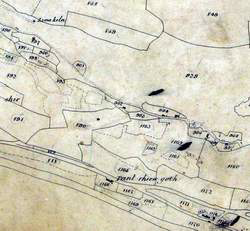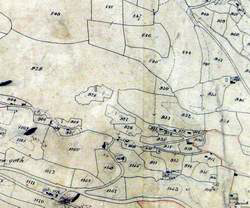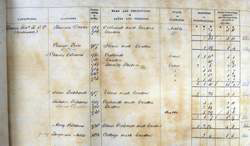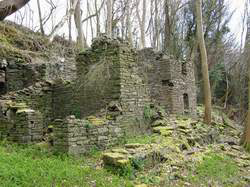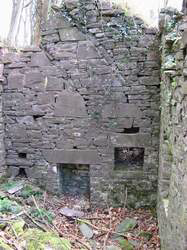Abandoned Communities ..... Y Graig
The section of the schedule map that shows Y Graig is reproduced on the left. Looking at the list of land holdings we find that several tenants at that time occupied areas of about half an acre to an acre or so. Mary Williams, for example, occupied 1 acre, 2 roods, 14 perches, with a garden and an orchard as well as her house. Her rent was 4s 3d per annum. John Pritchard had a house and garden, holding just over an acre and owing a rent of 4s 5d. Eleanor Price had a house and garden, holding just under half an acre and owing a rent of 1s 4d. The owner of all these holdings was Rev R N P Davies.
Mary Williams lived in house PRN 5835 at OS 258163, John Pritchard in house PRN 5825 at OS 261160, and Eleanor Price in house PRN 5839 (the house bearing the date 1746) at OS 257161. Schedule entries for all three of these properties can be seen in the photograph on the left.
The schedule contains strong evidence that the community had started to decline by 1842. John Edwards had a house, garden, and orchard in the central part of the settlement, but he was also the tenant of several plots near the western end that now contain the ruins of houses (PRN 5849, 5850, 5851, and 5855). In the schedule these plots are described as grass or arable (see photograph on the left). There is no mention of houses on them. It is just possible that these houses were built after 1842, but more likely that they were built earlier and had already been abandoned by that date.
The tithe schedule also refers to the property of John Lloyd, mentioned earlier as one of the defendants in a court case in 1855. His house (PRN 5819) and garden covered just under an acre, and he also occupied a small adjacent plot described as arable land. The schedule asserts that John Lloyd was the owner of these two areas, but of course it was later determined in the court case that he was not the owner.
The newspaper report of the 1855 court case makes it clear that the dispute over ownership had been going on over many years. It also gives hints about the way of life of John Lloyd and his family. We learn that John Lloyd's parents had occupied the property, and John Lloyd had taken it over on the death of his mother Gwenllian some thirty years earlier. Gwenllian Lloyd had resisted demands for rent payment, and as she had been so poor the owners of her property had allowed her to stay without paying. But when John Lloyd started to take stone from a local quarry and cut down timber they decided to take legal action against him.
At one point John Lloyd himself was asked to answer questions. He had to be led into the dock as he was totally blind. He recalled that his mother had kept goats and ponies. He himself had kept cows, sheep, donkeys, and pigs, which he had put out to pasture on the unenclosed parts of Y Graig. He readily acknowledged that he had often cut timber for his own use and taken stone from the quarry, believing it was his right to do so.
After the jury had found in favour of Davies and Bailey the judge imposed damages of forty shillings on John Lloyd and his son (also John Lloyd). It is very unlikely that they were able to pay this amount, and soon afterwards they were detained as Prisoners of Debt in the gaol at Monmouth. Records indicate that on 1 April 1858 the younger John Lloyd had been held there for more than twelve months, and that on 16 April 1860 the older John Lloyd, then aged about 67, had been there for over four years. I do not know when they eventually regained their freedom.
Three
West and central parts of Y Graig
Central and eastern parts of Y Graig
Schedule entries for some of the properties
Photographs of the Tithe Agreement and Schedule are reproduced with the permission of the Gwent Record Office
John Lloyd’s house, PRN 5919
The bread oven inside John Lloyd’s house, and above it an unusual sloping flue
Plots occupied by John Edwards
